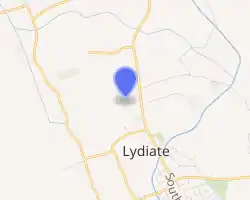Lydiate Hall
Lydiate Hall was a 16th-century hall in Lydiate, Merseyside, England. The hall was a black-and-white half-timbered house, and was similar in design to Speke Hall. The hall was accompanied by a private chapel. It was a known Catholic house during the time of Elizabeth I of England, and the building contained at least three priest holes. The hall became a ruin in the early 20th century, and is now part of the grounds of Lydiate Hall Farm on Southport Road, Lydiate. It is now part of a conservation area, along with the nearby Scotch Piper Inn and St Catherine's Chapel.[1] Its ruins were Grade II listed in 1968.[2]
| Lydiate Hall | |
|---|---|
.jpg.webp) Lydiate Hall in 2014 | |
 | |
| General information | |
| Town or city | Lydiate |
| Country | England |
History
Construction and early history
The building was constructed in the 15th and 16th century, and was altered in the 19th century. The founders were Laurence Ireland and his wife Katherine Blundell. Ireland is believed to been responsible for the later extensions to the house sometime around 1451.[3] The building was originally a quadrangle plan with an enclosed courtyard, with the front being the oldest portion of stone construction and surrounded by a moat. During the late 18th century, then owner Henry Blundell authorised significant demolition of the hall, particularly the areas that were considered picturesque and in turn removing all trace of the principle frontage.[4]
19th century

By the late 1880s, then owned by Mr Weld-Blundell of Ince, it was described as "fast decaying".[3] and as being in a dilapidated state, with no repairs being undertaken.[4] In 1907, the unoccupied property was burgled of its family heirloom paintings, which had to remain in the property under a clause in the will of a previous owner. The stolen artwork were cut from their frames, with the thieves said to "have gone about their work with great deliberation".[5]
20th century
As of the 20th century, the foundations exist, along with the brick and stone structure with 19th century windows on the ground and first floor; the timber-framed hall was completely demolished. A partial collar and strut roof with moulded tie beams remained as of 1985, as well as a Tudor-headed fireplace with shield and cornice and a 19th-century range.[2]
See also
References
| Wikimedia Commons has media related to Lydiate Hall. |
Citations
- "History of Lydiate". Lydiate Parish Council. Retrieved 1 March 2014.
- Historic England. "Remains of Lydiate Hall (1075840)". National Heritage List for England. Retrieved 1 March 2014.
- Russell 1882, p. 135.
- Russell 1882, p. 136.
- "Heirlooms Stolen". The Buckingham Post. 10 May 1907. p. 3.
Sources
- Russell, Matthew (1882). The Irish monthly magazine.